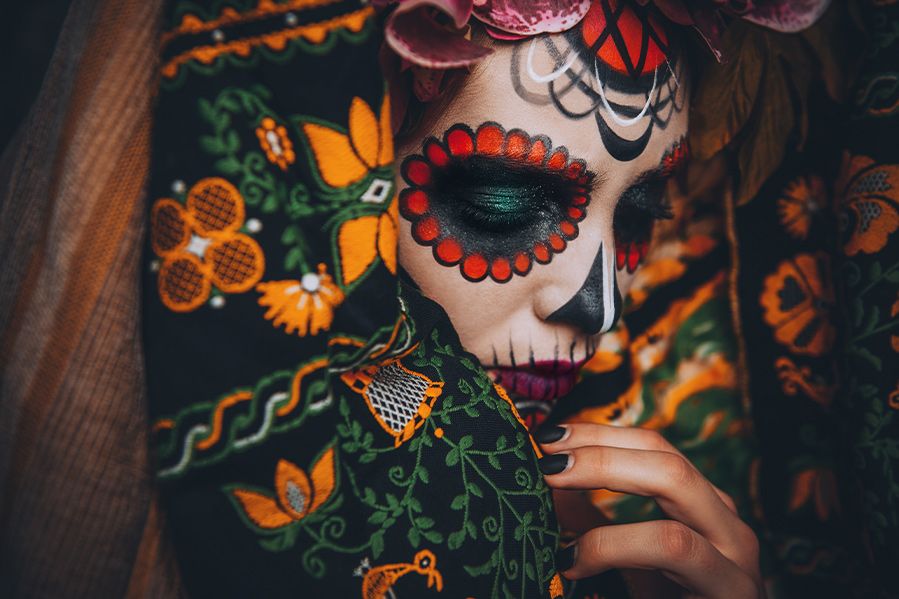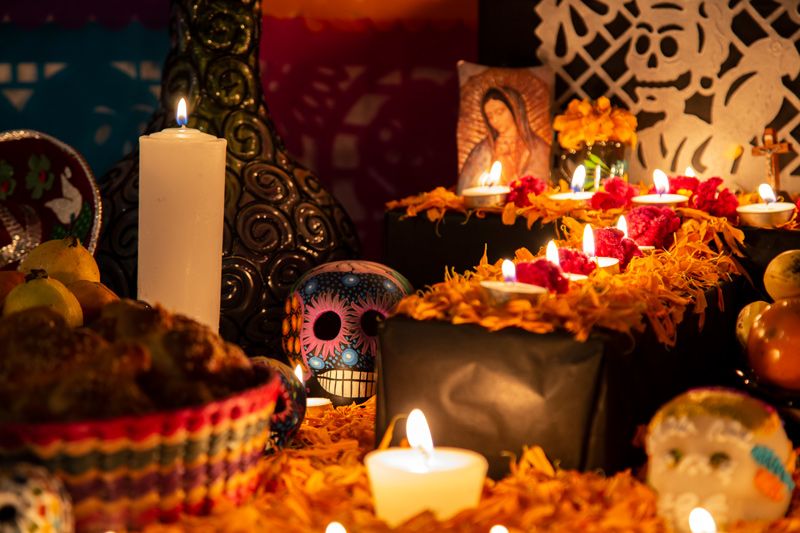
For millions of families in Mexico and those of Mexican heritage abroad, the Day of the Dead – Día de los Muertos – is the time when the wall between our world and the spirit world dissolves, and the spirits of the dead can rejoin their families for 24 hours.
With elaborately decorated altars, intricate makeup, and an offering of the deceased’s favorite food and drink, revelers welcome back their family members as honored guests with an elaborate celebration, before the soul of the dead must return to the spirit realm.
The Day of the Dead is a unique holiday to the Mexican people, a time in which life is celebrated and death is recognized as a quintessential part of being human.
What is the Day of the Dead in Spanish?
Day of the Dead translates to Día de los Muertos in Spanish, and that's what you'll commonly hear the holiday called.
Día de los Muertos is a two-day celebration starting at midnight on November 1st. According to folklore, the gates of heaven open, and dead children can join their families for 24 hours. On November 2nd, the spirits of adults can follow suit.
Before the Day of the Dead, the living create ofrendas, or offerings, in honor of the visiting spirits. These are elaborately decorated altars, often adorned with marigold flowers, candles, brightly colored sugar skulls, and photos of the departed.

These ofrendas are highly personalized so that the dead can find their families.
For children, called angelitos (little angels), they might include important items like favorite toys and treats. And for adults, ofrendas will be decorated with traditional Mexican dishes like tamales, mole, and even tequila, as well as items specific to the deceased’s particular tastes, such as their favorite food and drink.
These are not solemn holidays. Rather, the nights are filled with laughter and amusing stories about the dead, in what is often a raucous celebration in their honor. With the ofrenda guiding the deceased home to their family from the realm of the spirits, they can enjoy one last meal with loved ones, as they did when they were alive.
How are Halloween and Day of the Dead Similar?
Some people mistake Day of the Dead for a sort of Mexican Halloween, probably due to the "spooky" name and close proximity on the calendar.
As it turns out, although their origins are totally different, the two holidays do have some elements in common.
Halloween has its roots in the ancient pagan traditions of pre-Christian Europe and traces back to a festival known as Samhain, which was held at the end of October.
During this time, it was believed the veil between the realm of the living and the dead was at its thinnest. Sound familiar?
Like the Day of the Dead, Halloween also incorporates images associated with death – skulls, skeletons, etc.
Finally, sugar is an important component of both holidays (albeit, in different forms). Halloween is anticipated by children for the sweet, sweet candy haul that comes with it. Those celebrating Day of the Dead, on the other hand, use sugar to make skulls – usually representing deceased family members – which are then decorated and displayed.
But while there are plenty of similarities, Halloween and Day of the Dead are entirely separate holidays.
And although Halloween growing in popularity in Mexico, it is primarily viewed as a children’s holiday and is typically overshadowed by the Day of the Dead.
What are the Origins of Day of the Dead?
The origins of the Day of the Dead, on the other hand, go back 3,000 years to the Aztecs who once lived in central Mexico.
Believing that life was cyclical, the Aztecs made offerings of food, water, and tools for the dead to assist them on their yearslong journey through the Chicunamictlán, the land of the dead, their final destination being Mictlán, the Aztec underworld.
It is this tradition that the modern Día de los Muertos took great inspiration from.
Day of the Dead is one of the most revered and celebrated holidays in Mexico, but its reach extends far beyond the borders of Mexico. It is also celebrated in the Philippines, many countries in South America, as well as communities in the United States with large Mexican populations, including Texas, California, New Mexico, and Arizona.
Wherever you are, celebrating the Day of the Dead is a great way to honor the life of your departed loved ones with the people that mattered most to them. It is a spiritual and uniquely Mexican celebration of life – and death.
Feliz Día de los Muertos!
8 comments
-
What happens in October to the leaves on the trees. They turn color and die. The death of the summer. Time to party. All the crops are in and in two months it is December 21 then the days get longer or the nights get shorter. Time to party.
-
Day of the Dead is another example of the Aztec culture bridging the more modern (and forced with torture and death and hatred and cruelty) All Saint's Day by co-opting similarities, the same way that ancient pagans bridged Samhain to the Christian holiday. So the mythologies of newer religions/beliefs subsume the old ways, but do not always entirely erase them. How did cultures survive the forced- or even just the eventual- changing from their ways to another system? By finding these spiritual bridges. And so it continues to this day.
-
I learned of Dia de Los Muertos many years ago. Growing up in or near Mexican-American communities made it easy to see the celebrations. I find it interesting to see how different ethnicities/nationalities celebrate similar holidays.
-
Halloween is far better. Women dress is skimpy revealing outfits and come knocking at your door. They don’t do that on the Day of the Dead.
-
Isn't the Catholic "All saints day" Nov 1, too???
-
Yes.
-
Yes, and All Hollow's Eve (The night before All Saints Day) became Halloween.
In a sense, Halloween became a religious holiday as the night before All Saint's Day. Of course, very few look at it that way but it does make for a good debate.
-


I thought this article was well researched and I enjoyed it! 'Celebrating our dead' is a way of mitigating our grief and the hole in our hearts when someone close to us dies... I'm sure that most know there are cultures who keep the bodies of family members in caskets that are easily opened. They remove their body, adorn it with flowers and favorite foods and parade it with friends and family. Tobacco and alcohol are offered and shared during the celebration and then they are placed back into their casket, until the next year. I admit, it is an odd tradition (to me) but is a tradition that brings a little joy into the participants lives and is their way of honoring their dead. Who am I to tell them 'That's wrong'? A few years ago, a good friend died and was cremated. His wife gave me a small glass ball with some of his ashes inside. I tied the leather thong it hung from to my handlebars on my Harley and would 'Take him for a ride' wherever I went. I went for a 200-miler one day and when I got home? Smokey's ball was gone! I grinned and said "Wherever you are Bro, I'm glad some of you is now On The Road!"